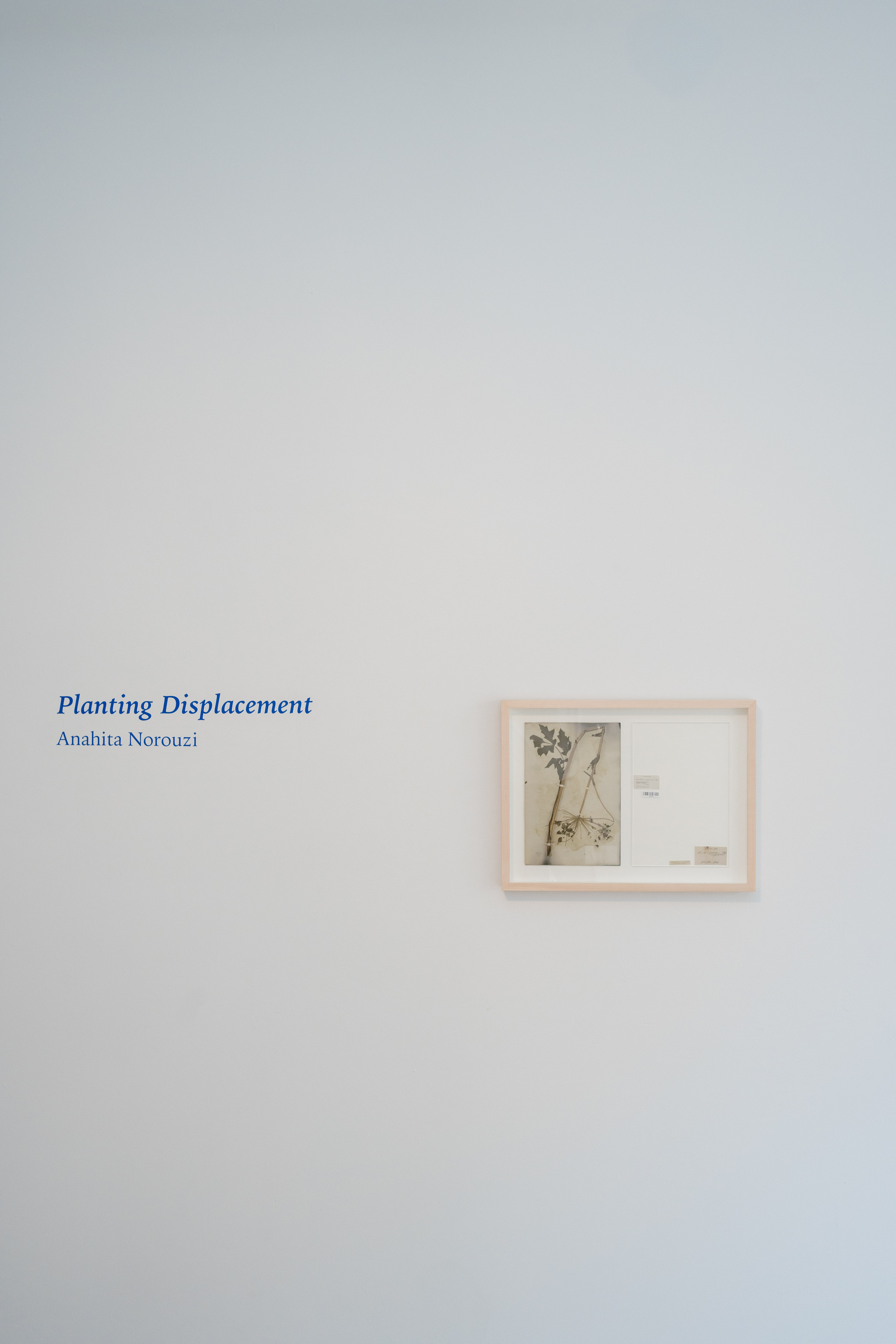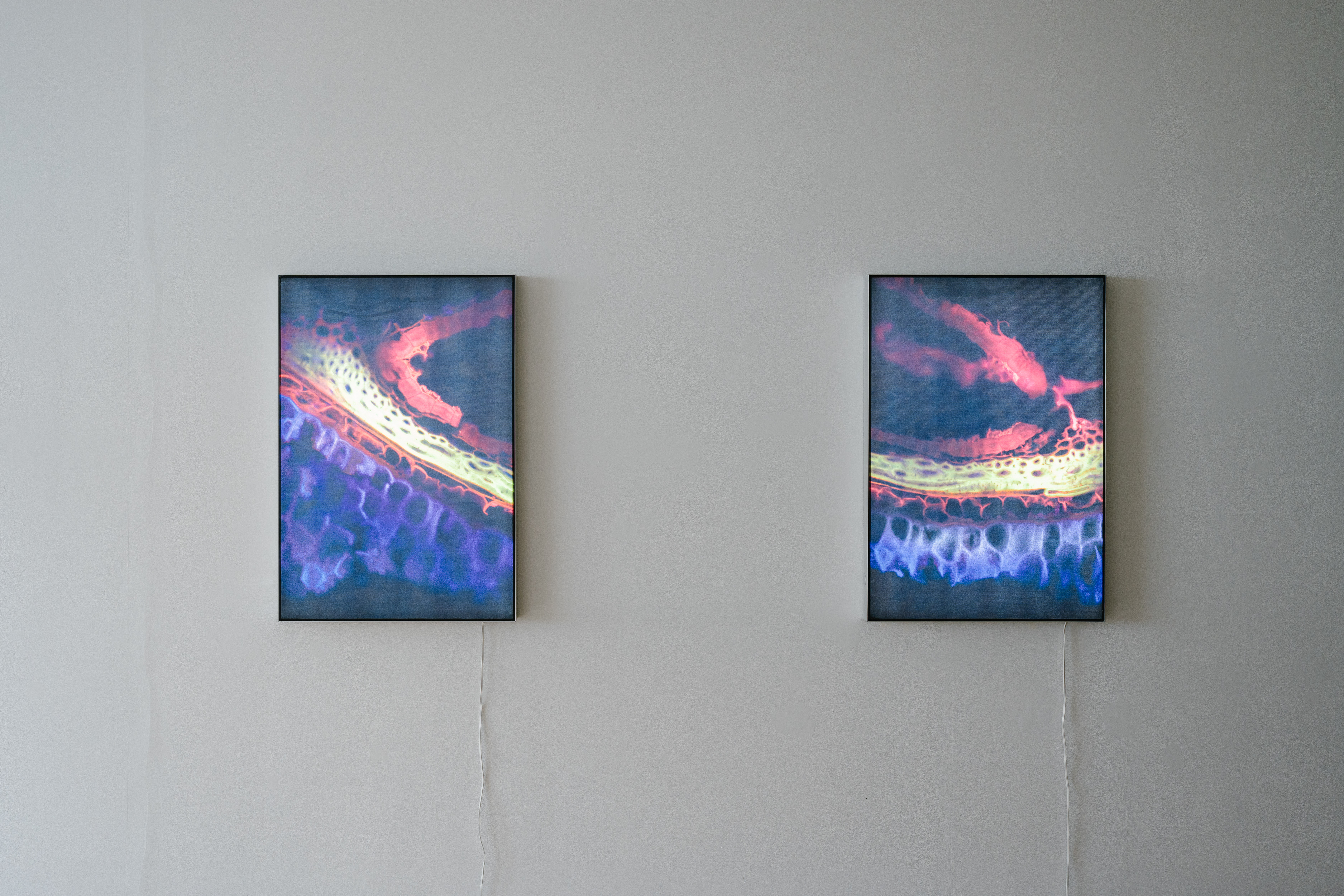Mainspace Exhibition /
Planting Displacement
Anahita Norouzi
September 8 - October 21, 2023
Opening Reception: September 8, 7-9PM
@ The New Gallery, 208 Centre St SE




The work of Montreal-based Iranian artist Anahita Norouzi stems from her long-term research into the intersections of identity and memory, especially in relation to experiences of immigration and displacement. This exhibition examines the legacies of botanical explorations, when scientific research and agricultural production became entangled in the exploitation of non-Western geographies, shaping cultural attitudes towards the human and non-human “other.” By underlining hostilities towards displaced persons and migrating plants alike, through terminology used to describe both as foreign and invasive, Norouzi draws attention to the fragile and conflicted state of those who had to leave their homes behind.
Planting Displacement brings together an expansive body of her work that includes archival documents, photographs, cyanotypes, sculptures, and video, all of which investigate the plant colloquially referred to as giant hogweed. Originating in Southwest Asia and known in the artist’s ancestral homeland of Iran as Heracleum persicum (Persian hogweed), the plant spread to the West in the nineteenth and twentieth centuries through European colonial interventions, trade routes, and Western interest in acquiring “exotic” species. In recent decades, it has been recognized as a noxious weed in Canada affecting native flora and fauna, and human beings too, due to its toxic sap. Today, there are national campaigns to not only ban the cultivation of this plant, but to also eradicate and curb its growth. Norouzi sheds light on the history and changing perceptions of giant hogweed, while marking its gradual disappearance.














Photo Documentation by Danny Luong
Colonized Plants
Amin Alsaden
Anahita Norouzi examines the relationship between those who have had to leave their homes behind and the places they now inhabit. This is a deeply personal question for the artist, as well as those of us who found ourselves in the conflicted and fragile position of immigrants or refugees obliged to adapt to new, and often hostile, surroundings. But she has been investigating this question through a proxy: the migrations of plant species, particularly those originating in Southwest Asia (or the “Middle East”). Norouzi interrogates the transnational legacies of botanical explorations, especially when scientific research and agricultural production became entangled in the colonial exploitation of non-Western geographies. At the core of her current preoccupations are the inextricable links between human beings, plants—or the planet’s ecology at large—politics, economics, history, and the geographies across which all of these unfold.
Norouzi has developed a specific body of work that includes archival documents, photographs, sculptures, and videos, which look into the plant colloquially referred to as giant hogweed. Known in the artist’s country of origin, Iran, as Heracleum persicum (literally “Persian hogweed”), the plant spread to the West in the nineteenth and twentieth centuries, through European colonial interventions, trade, and interest in acquiring so-called exotic species. In recent decades, it has been recognized as a noxious weed in southern Canada, affecting native plants, wildlife, and humans alike—its toxic sap can cause serious burns on contact. Today, there are national campaigns to not only ban the cultivation of this plant, but to curb its growth, and eventually eradicate it altogether. Norouzi sheds light on the history and changing perceptions of giant hogweed, while marking its gradual disappearance from Canadian and other Western environments.
This is not an abstract research subject for the artist, because she comes to it from the intimacy of lived experience. Her research is largely anchored in the close relationship between her family and this species. The work Untitled (2021), consisting of glass bottles with salt, pepper, and golpar (seeds of the Heracleum persicum), is inspired by the containers that Norouzi’s grandmother used to preserve pickles. In Iran, ground golpar is an essential ingredient, like salt and pepper, for preserving food. The work can be seen as a metaphor for attempts at preserving a community’s identity in the diaspora through maintaining its distinctive cuisine. It also recalls the artist’s memories of joining members of her family as they walked the landscapes of Iran, harvesting the seeds, which speaks to a caring embrace of this plant—prized for its culinary and healing potential, nurturing despite its defense mechanisms—a relationship that has nothing to do with the fear and anxiety surrounding giant hogweed in Canada today.
Norouzi juxtaposes private recollections and her community’s practices with more institutional memories of this species, as it made its way to Western landscapes, often accompanied by attempts to describe, categorize, and impose disciplinary projections onto its sensationalized form. The work Arid Florilegium (2022) captures her efforts to retrieve instances of how the plant has been registered by Western botanists: she reached out to different herbariums in Europe and the United States to inquire whether they held specimens of the Heracleum persicum, collected specifically from Iran, in their repositories. She received images of various samples acquired over the past century. She then intervened digitally into those images, removing all the added information, including labels with taxonomic classifications, recreating an uncontaminated form of the plant, an act of resistance that reclaims the representations of the species. In the lightboxes what we put in. what we leave out. (2022), Norouzi presents two microscopic images side by side, the first taken from a seed of Heracleum persicum collected from Iran, and the second from a giant hogweed in Canada. The images highlight the anatomy of these reproductive pods, creating an intimate portrait, devoid of external assessments or motives.
The exhibition raises a series of questions about how the natural environment might register, and inadvertently reveal, the histories and traumas of colonization. It asks: what if those of us who have been displaced due to warfare and military interventions, perpetrated by Western colonial powers, identify plants from our homelands in the landscapes of Canada? Could this recognition lead to further alienation, especially as we grapple with our place and sense of belonging, when we realize that these plants are now labeled “invasive” and “foreign” species impacting more delicate native flora? How does this language feed into the racism and xenophobia directed towards racialized newcomers, and broader constructions of self and “other” in Canada? How do immigrants—those who have been here for centuries, as well as more recent arrivals—make sense of our own fraught relationship with this terrain, as settlers on Indigenous territories? The exhibition probes the complex intersections between the agonies and burdens of forced movements, of both people and other species, and our responsibilities towards the lands we inhabit.
Underlying this exhibition, and the artist’s multipronged investigations, is the spectre of colonialism, which continues to haunt the world today. While settler colonialism is denounced by Indigenous communities in Canada and elsewhere, other forms of colonialism—visible or not, current or supposedly past—are perhaps less evident, but no less violent. Colonialism has sown the seeds for a massive global displacement of people and other species, at times recklessly relocated to meet the economic and political interests, or simply the whims, of dominant powers. The exhibition exposes colonialism, with its exploitative and extractive operations, as the root cause of much human and non-human misery. It also hints at a glimmer of hope: only by coming to terms with the ravages of colonialism, and how it continues to manifest itself today, that we might begin to address, and perhaps ameliorate, its devastating repercussions.
Anahita Norouzi is a multidisciplinary artist, originally from Tehran and active in Montreal since 2018. She holds advanced degrees in Fine Arts and Graphic Design from Concordia University in Montreal. For the past 5 years, she has been traveling often between Iran and Canada to conduct her research which lies at the intersection of colonial histories, experiences of immigration and displacement, and the issue of identity and memory.
Her practice is research-driven, instigated by marginalized histories and the legacies of botanical explorations and archeological excavations, particularly when scientific research became entangled in the colonial exploitation of non-Western geographies. Articulated across a range of materials and mediums including sculpture, installation, photography, and video, her work interrogates different cultural and political perspectives on the human and non-human “other,” underlining the complex space between the conflicted state of displaced people, plants, and cultural artifacts, and the responsibilities of the host country.
Amin Alsaden is a curator, educator, and scholar whose work focuses on transnational solidarities and exchanges across cultural boundaries. With a commitment to advancing social justice through the arts, Alsaden’s curatorial practice contributes to the dissemination of more diverse, inclusive, and global narratives, by challenging hegemonic knowledge and power structures. Alsaden’s research explores the history and theory of modern and contemporary art and architecture globally, with specific expertise in the Arab-Muslim world and its diasporas. He has published and lectured widely.
